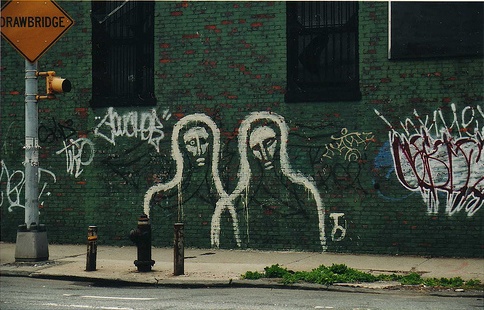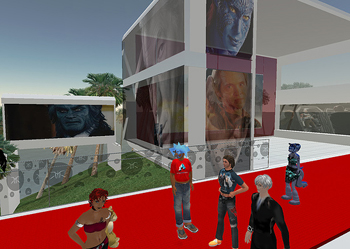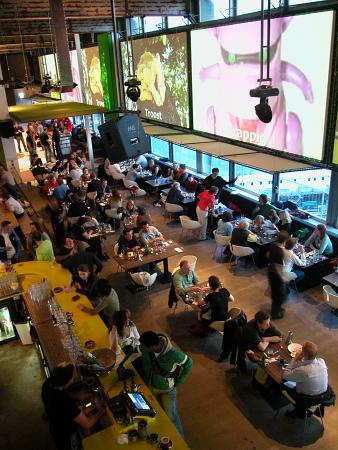Amazing. I’ve installed the Photosynth preview on my own machine (sadly it seems to work in IE only on a PC—not surprising, but a little disappointing), and I am zooming around in the Piazza San Marco courtesy of photos shot by a Photosynth Program Manager. The experience is incredible, and totally unique.
There are questions that arise: Is participation something that is voluntary, or is it something more ubiquitous and automatic that will just happen when you upload pictures to the web? (In the case of the preview that I’m running, we can assume it was a Microsoft sponsored trip. But the question is pertinent for future plans.) What are the mechanisms in place to provide privacy? What are the mechanisms to allow for editorializing; for instance, what if I wanted to see only shots taken at night? The images I’m looking at of Saint Mark’s Plaza were all shot by the same person on what looks like the same day with the same camera. How will this work with a different set of images taken with different hands, shutter speeds, attention to details like focus, lighting, foregrounding, etc.? And a larger, geographical and geopolitical question: how were these sites chosen? Will we (the public) be able to contribute models as well as photos so that I can make my city block a photo-navigable space? Or, more importantly, someone in São Paulo can make a map of their city block?
But aside from the questions, this is the most exciting way to view photos from the ‘net that I have ever seen.
Category Archives: flickr
plato’s cave
HiddenHistory on Vimeo
Ben’s post last week on the darker side of flash shone like a light bulb. I’d spent the morning manipulating a scanned image of Ditr Roth, by taking this video clip from Vimeo and downloading the source quicktime (which Vimeo allows you to do) importing that into i-movie and exporting thirteen still images as jpegs to sequence into an animated gif. Then I started pulling wav. files off cds and layering tracks and looping them and turning them into mpegs. In other words, it was a day like any other, but when I read Social Powerpoint, I considered how many little media format borders I’d just crossed and how many times I cross those borders on any given day in any given post and how much I take that freedom for granted. So, is flash like that damn wall they keep threatening to build in Texas, or built once in Germany and before that in China (and as a bird, or a bowerbird knows….walls never really work if you can fly over them, or go around)?
I don’t know enough about flash coding, but I worry that these walls are all already there in the very way that people read different media. In the way that their eyeballs see them and their earballs hear them. A photograph and a drawing will both appear on a digital page as jpegs, but it still seems a little tricky to get people to look at them in relation to each other. In painting, you take two paintings and put them side by side: BANG, you have a diptych. It becomes a third thing. I thought that logic would translate very easily to a still image and a moving one, or a sound and word, but It seems that people like compartments. They like to have their still photos at flickr and their video on You tube and their music on i-tunes, and their book on tape as a podcast, etc. If things appear on a digital page together, they are meant to be surrounded by a trompe l’oeil metallic players just so that there’s no aesthetic miscegenation going on. It’s what we’re used to.
I tend to use a bunch of media sharing services for IT IN place both as a way to host media and as a way of advertising. One of the realities I’ve come to deal with is that many more people are going to see my work as discrete media objects on flickr and vimeo than will ever make it to the blog to read these things together in the way that I intended. People seem to get something out of the picutres and the videos as pictures and videos, etc., but I always feel they are missing half the point. I think of it as reading sentence fragments, or stanzas and never seeing the whole poem.
At this point, each media is like a different language and trying to put them all together into a single whole is a Wasteland exercise… and the wasteland is patrolled by Minutemen and snakes.
Maybe, in some ways throwing these fragments out into the digital desert is part of the poetry. Maybe the networked landscape offers the thrill of archeology for the reader, like digging up little photo, sound, and video tiles that lead the reader on to find the mosaic. Today someone left a comment on flickr:
“your pieces are like secret boxes.. when i click the link it’s like lifting a lid and inside there is always something surprisingly ‘other’ and beautiful..”
….I could tack a hundred paintings on a hundred walls and never get a such a nice sentence in return.
But then there is the voice of my mother and also the significant other saying, “So how do you make money?”
It’s important to point out that for me the nexus of meaning is in mark making (wether as writing, or drawing which I think are intimately and evolutionarily (?) cave connected). My practice always revolves around drawing… All the different media I use are like a series of mirrors that multiply all the possible ways to see and understand things, but as an art animal, my primary way of knowing where I stand in the funhouse is to make a mark and so I think my practice revolves around the drawings… they are the map, if you will. While not exactly having any sort of business model, I always figured digital media would lead people to want to see and maybe own the “original” drawings and paintings. Of course, I thought of it this way, because that’s just what people traditionally have done: they sell things to people who collect things. It’s what we’re used to.
Maybe the past few months of deciphering fluxus history (and it’s anti-art leanings) has put the zap on my head, but lately I’m a bit lost in a Labyrinth of my own creation. The blog has sort of become the work of art and none of it’s discrete parts (read media) are more or less important…not when I’m successful in a post. It may be Greek and Latin and French and German and English and Japanese, but it has to be read together if you want to get the jokes. I don’t know… maybe I’m speaking in tongues. I have a feeling the youtube generation will be malf blahming flah wast di blamspoontoop dang glover….
* addendum: as I wrote this, three people on flickr enquired about buying work.
– my Flickr page
– my Vimeo page
what would susan sontag make of flickr?
This post takes a bit of a set-up. Six times over the past twelve years (including the last four) I’ve had the lucky opportunity to spend a bit of the summer on the northeast coast of Sardinia. The place is filled with contradictions. The landscape is arid, almost desert-like, yet it merges effortlessly with the sea. The gentle wind, lapping waters and sublime beauty disguise a harsh reality–the rocks on land and sea are sharp and unforgiving of error. The stone on the land is red granite but THE rock, the 2 mile long, nearly one-mile high island that dominates the seascape is uncharacteristically made of limestone. There is no electricity except in the kitchen and workshop. We live in concrete-floor huts down by the water. We are always aware of nature here — both its beauty and its danger. For reasons too complicated to go into now, I am also acutely aware of differences of class and race here. The overall effect of these contradictions is that I am extremely conscious of where I am and how lucky I am to be here.
The other day I read John Berger’s 1978 essay, “The Uses of Photography,” in which he reflects upon the ideas in Susan Sontag’s seminal book, On Photography.
Berger quotes Sontag:
A capitalist society requires a culture based on images. It needs to furnish vast amounts of entertainment in order to stimulate buying and anaesthetize the injuries of class, race and sex. And it needs to gather unlimited amounts of information, the better to exploit the natural resource, increase productivity, keep order, make war, give jobs to bureaucrats. The camera’s twin capacities, to subjectivise reality and to objectify it, ideally serve these needs and strengthen them. Cameras define reality in the two ways essential to the workings of an advanced industrial society: as a spectacle (for masses) and as an object of surveillance (for rulers). The production of images also furnishes a ruling ideology. Social change is replaced by a change in images.
Then he raises the question of whether there is a new way to conceive of the social purpose and practice of photography:
Her theory of the current use of photographs leads one to ask whether photography might serve a different function. Is there an alternative photographic practice? The question should not be answered naively. Today no alternative professional practice (if one thinks of the profession of photographer) is possible. The system can accommodate any photograph. Yet it may be possible to begin to use photographs according to a practice addressed to an alternative future.
. . . . For the photographer this means thinking of her or himself not so much as a reporter to the rest of the world but, rather, as a recorder for those involved in the events photographed [emphasis added]. The distinction is crucial.
The passage in bold above hit me like a ton of bricks. The midday meal here is the important one. The guests and staff eat together on a shaded platform looking out at the island described above (think Ayres Rock rising out of the water rather than planted in the desert). The recipes are local; the ingredients almost all grown on the property or caught in the sea at our doorstep. The result is about as perfect as a meal can be — completely in synch with time and place. I’ve made it a habit each day to photograph the food as it is laid out buffet style. I do this for myself but also for “foodie” friends back home. After reading Berger’s note above I realized how wrong-headed this “reportage” has been. My photographs of beautifully prepared food do not include any hint of the effort required to grow and prepare it, the sublime surroundings in which both staff and guests eat together, or the feelings of well-being that the experience engenders in us all. [I know that last sounds self-justifying or at the least absurdly naíve, but for now you’ll have to accept my sense that even the most well worked out social hierarchies, can under certain conditions and at certain moments turn into their opposite.]
Berger goes on to suggest that key to a new photographic practice is the construction of context:
The alternative use of photographs which already exist leads us back once more to the phenomenon and faculty of memory. The aim must be to construct a context for a photograph, to construct it with words, to construct it with other photographs, to construct it by its place in an ongoing text of photographs and images.
Photographs, at least those which intend to “report” preserve an instant in an ocean of time and therefore Berger contend they require context to give them meaning.
Which in turn brings me to the question of this post which I very much hope some of you will chime in on — what would Susan Sontag have made of Flickr? Originally, it seems, Flickr was conceived simply as a personal repository of images. In that sense it provides no antidote to the current practice of photography. However, as it begins to grow into a social network, where individuals begin to provide context and meaning to images, is it possible that Flickr could be a step to a new practice of photography. If so, what sorts of functionality need to be developed for Flickr and other related tools?
flickr as virtual museum

A local story. The Brooklyn Museum has been availing itself of various services at Flickr in conjunction with its new “Grafitti” exhibit, assembling photo sets and creating a group photo pool. In addition, the museum welcomes anyone to contribute photographs of grafitti from around Brooklyn to be incorporated into the main photo stream, along with images of a growing public grafitti mural on-site at the museum where visitors can pick up a colored pencil and start scribbling away. Here’s a picture from the first week of the mural:

This is an interesting case of a major cultural institution nurturing an outer curatorial ring to complement, and even inform, a central exhibit (the Institute conducted a similar experiment around Christo’s Gates installation in Central Park, 2005). It’s especially well suited to a show about grafitti, which is already a popular subject of amateur street photography. The museum has cleverly enlisted the collective eyes of the community to cover a terrain (a good chunk of the total surface area of Brooklyn) far too vast for any single organization to fully survey. (The quip has no doubt already been made that users be sure not forget to tag their photos.)
Thanks, Alex, for pointing this out.
future of flickr
 Wired News reported last week, that some users of Flickr were upset at the enforcing of, until now a rarely mentioned, Flickr policy of making non-photographic images unavailable to the public if the account does not mostly contain photographs. Although Flickr is mostly known as a photo sharing site, people often post various digitized images into Flickr including our collaborator, Alex Itin. Currently, users of Second Life are receiving particular attention with Flickr’s posting policies.
Wired News reported last week, that some users of Flickr were upset at the enforcing of, until now a rarely mentioned, Flickr policy of making non-photographic images unavailable to the public if the account does not mostly contain photographs. Although Flickr is mostly known as a photo sharing site, people often post various digitized images into Flickr including our collaborator, Alex Itin. Currently, users of Second Life are receiving particular attention with Flickr’s posting policies.
The article quotes Stewart Butterfield saying, “the rationale is that when people do a global search on Flickr, they want to find photos.”
I can appreciate that Flickr wants to maintain a clear brand identity. They have created one of the most successful open photo sharing websites to date and, they don’t want to dilute their brand. However, isn’t this just a tagging issue? It is ironic that Flickr, one of the pioneering Web 2.0 apps, whose success strongly relies on the power of folksonomy, misses this point. Flickr was one of the primary ways the general public figured out how tagging works, and their users should be able to figure out how to selection what kinds of images they want.
How much of a stretch would it be for Flickr to become an image sharing website, including tags for photographs, scanned analog images, and born digital images?
FInally, Second Life had a recent event with a tie-in to a virtual X-Men movie premiere, whose images made their way into Flickr. When asked to comment about it, Butterfield goes on to say, “Flickr wasn’t designed for Universal or Sony to promote their movie. Flickr is very explicitly for personal, noncommercial use” rather than “using a photo as a proxy for an ad.”
Again, I appreciate their sentiment. However, is there a feasible way to enforce this kind of policy? Is it ok to for me to post a picture of my trip to Seattle, wearing an Izod shirt, holding a Starbucks cups, in front of the Space Needle? Isn’t this a proxy for an ad? As we have noted before, architecture, such as Disneyland, the Chrylser Building and Space Needle are all copyrighted. Our clothes are plastered with icons and slogans. Food and drinks are covered with logos. We are a culture of brands and increasing everything in our lives is branded. It should come to no surprise that the media we, as a culture, produce reflects these brands, corporate identities, and commercial bodies.
The decreases in cost of digital production tools have vastly increased amateur media production. Flickr provides a great service to users of the web to support the sharing of all the media people are creating. However, Flickr created something bigger than they originally intended. Rather than limiting themselves to photo sharing, there is much more potential in creating a space for the sharing of and community building around all digital images.
“imaginative keyword conversations” – playing flickr on public screens

A wonderful hack of public space in Amsterdam. And on the top floor of the PostCS building no less, with breathtaking panoramic views of the city. Kim and I had the pleasure of spending two days there this past January at “A Decade of Web Design.”
The diners in bar/restaurant/club 11 will be subjected to the wrath of fellow visitors SMSing whatever keyword they want to the installation that pulls photos from the online community flickr and projects them onto Restaurant 11’s huge panoramic screens.
(via Smart Mobs)
